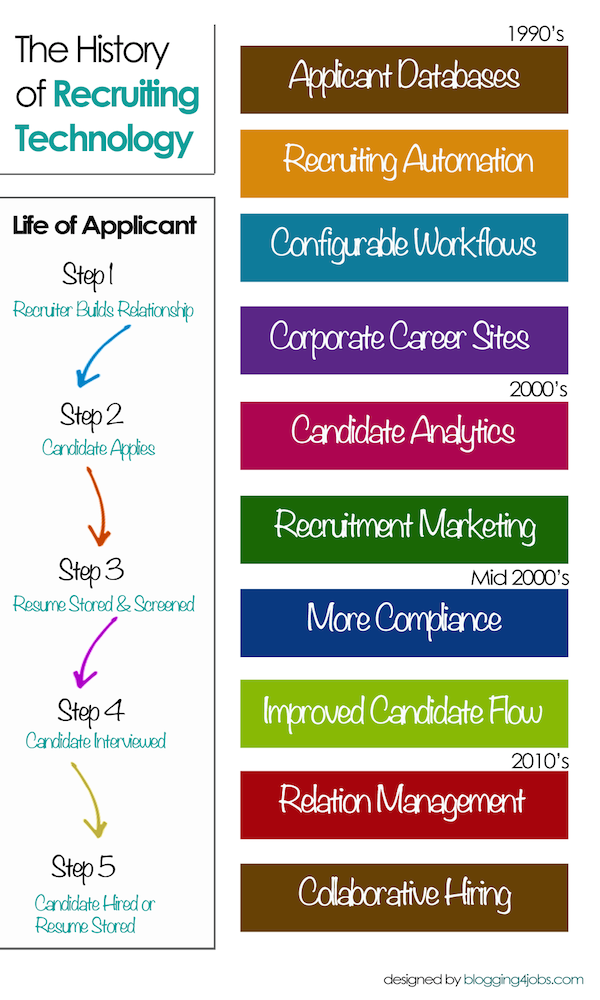Innovative Staffing Practices: A Look Back at Recruiting & Our Love Affair with Technology

As the need for new talent grows in our organization, the job of the recruiter, their responsibilities and the number of tasks also increases making the need for processes and workflows to be documented. Otherwise, we are running around like crazy chickens hell bent on hiring.
Technology has been revolutionary in increasing the effectiveness of processing, particularly in the recruiting industry. More importantly, it’s still a growing industry, with Forrester Research reporting that human capital applications (which recruiting technology is a part of) is likely to increase $3.5 billion from 2013 to 2017.
Technology and recruitment is a match made in heaven. They are soul mates, and I really can’t imagine an effective recruiting department driven by hiring and workplace analytics without the technology to justify our success and business needs. We are crazy in love with recruitment technology. When and how did this love affair in recruitment begin? Did recruiting simply leave compliance at the alter or did it find a better way with technology? Let’s take a stroll through memory lane, shall we?
1990’s: Applicant Database and Automation
Ushered in by the need to store candidate information and the desire to be more compliant as well as organized in data storage, recruiting technology was founded on the premise of applicant databases, recruitment automation and a configurable workflow to help maintain compliance programs, document storage requirements and help organize our candidate flow and recruitment processes. Recruiters saw technology as a way to aid in their compliance struggles allowing focus on the business at hand, which was making placements, interviewing and hiring candidates.
2000’s: Online Career Sites and Job Postings
The economy during this time period had saw better days making hiring the right candidates critical to the success of a budding business or growing industry. Most hiring assessments weren’t yet online or streamed but offered fill in the blank paper bubble forms we faxed in to places unknown.
As job boards grew in popularity so did the need to measure recruitment and hiring success focused on the ROI of online activities including niche job boards and corporate career sites. The early 2000’s brought forth my first experience with applicant tracking systems and online background checking. Recruitment marketing began as recruiters learned the fine art of an appealing LinkedIn message, email or online job posting. For myself, I surfed online forums and chat rooms finding great success in recruiting using online dating websites as a sourcing and candidate engagement strategy.
Mid 2000’s: Focused Compliance and Candidate Flow
Government agencies began to watch the recruiting industry’s adoption of technology and the World Wide Web. Integration began to grow in popularity as recruiters and HR grew tired of re-entering candidate information from the ATS to the HRIS like ADP. Hiring processes become more integrated and heavily online. Early 2006 resulted in the launch of web enabled compliance government tool, e-verify starting first slow with a little more than 11,000 companies.
I focused my efforts less on spray and pray efforts and relied on targeted tools when it came to recruitment marketing. I developed process flows and elaborate excel spreadsheets out of compliance fears from my VP regarding the OFCCP the viewpoint on Internet recruiting. Technologies to achieve aid in these efforts were available but bulky or complex so I relied on using referral platforms, phone sourcing and traditional networking with some online social recruiting components sprinkled in. My first foray into automated Facebook recruiting was with a company called JobMagic that was later acquired by iCIMS in 2012.
2010’s: Relation Management, Collaborative Hiring and Social Recruiting
As the economy began the slow process of recovery, the focus of recruitment process continued to evolve from the process and compliance side of the house towards recruiting, candidate engagement and the candidate experience as more than just hiring but marketing and selling and to where we are now in 2014.
While terms such as talent community, mobile and war for talent continue to dominate the discussion, I’m of the belief that the future of recruiting in 2014 really starts with collaboration and relationship recruiting that goes beyond a platform or technology and is focused squarely on the individual candidate and recruitment. This will be the most important development in the current evolution of recruiting, processes and our love affair with technology.
A special thank you also for this month’s Innovative Staffing Practices Leadership Sponsors, The Ladders and Linium Staffing. Please check our their innovative services!




